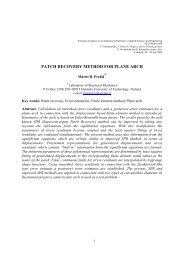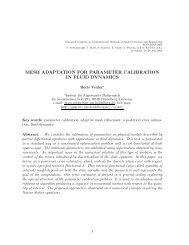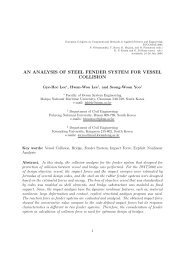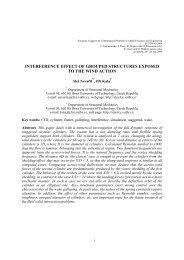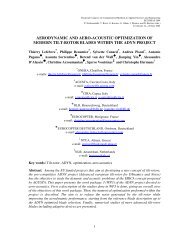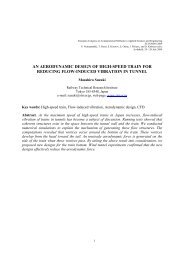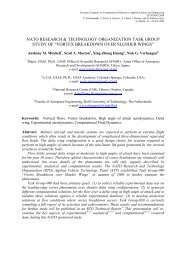Aerodynamic Design of Unmanned and Scaled Supersonic ...
Aerodynamic Design of Unmanned and Scaled Supersonic ...
Aerodynamic Design of Unmanned and Scaled Supersonic ...
Create successful ePaper yourself
Turn your PDF publications into a flip-book with our unique Google optimized e-Paper software.
K. Yoshida <strong>and</strong> Y. Makino<br />
generation SST, we used an original<br />
configuration for evaluating the real second<br />
generation SST.<br />
Consequently, we can obtain that the<br />
improvement <strong>of</strong> the L/D <strong>of</strong> a real large SST by<br />
applying present aerodynamic design technique<br />
is about 11% at cruise condition, compared with<br />
the L/D <strong>of</strong> Concorde (see Table 1). Figure 10<br />
shows estimated drag polar curves <strong>of</strong> some<br />
configurations. We can see a remarkable<br />
improvement on the real second generation SST.<br />
Here “Concorde” in the Table 1 dose not mean<br />
the exact Concorde configuration. It<br />
ONERA-S2MA : IR Image:M=2, Re MAC =4.7×10 6 (P 0 =0.6 bar)<br />
Flow<br />
23.3% model<br />
Hot-film sensors<br />
IR camera<br />
Transition line<br />
<strong>Design</strong> Point:α=2°<br />
Transition line<br />
Off-<strong>Design</strong> Point:α=-1°<br />
Figure 11. Transition test <strong>of</strong> NEXST-1 at ONERA<br />
corresponds to a Concorde-like configuration without nacelle, which was designed by JAXA<br />
according to the design philosophy described in other technical papers.<br />
2.4 Wind Tunnel Tests<br />
To complete the aerodynamic design <strong>of</strong> the NEXST-1 airplane, several wind tunnel tests<br />
were conducted <strong>and</strong> the detailed results are summarized in reference [17]. In this section, the<br />
principal results on confirming the NLF wing design concept are summarized below.<br />
In general, it is not easy to conduct any transition measurement tests at usual blow-downtype<br />
supersonic wind tunnels, because <strong>of</strong> the not-so-small freestream turbulence. However,<br />
we estimated relatively lower freestream turbulence level due to continuous flow than that <strong>of</strong><br />
any blow-down-type supersonic tunnels. Therefore, we conducted the transition measurement<br />
test at the supersonic closed-circuit-type tunnel <strong>of</strong> ONERA. It was called “S2MA” <strong>and</strong> had<br />
the largest test section among several tunnels available for us. We used a wing-body<br />
configuration test model with 23.3% scale <strong>of</strong> the NEXST-1 airplane (see Figure 11).<br />
The infra-red (IR) image technique as well as multi-element hot-film sensors was utilized<br />
in detecting transition location. The total pressure fluctuation measured by JAXA was about<br />
0.29% using an unsteady pressure transducer placed on the model. Even though this value<br />
was not so small, we clearly confirmed the rearward movement <strong>of</strong> the transition location at<br />
the design point condition (angle <strong>of</strong> attack 2.0 degrees) as shown in Figure 11 [18]. However,<br />
the amount <strong>of</strong> the transition movement was not the same as the predicted result by our<br />
LSTAB code because <strong>of</strong> the freestream turbulence. Therefore, we are expecting that complete<br />
validation will be conducted in the flight test.<br />
3 AERODYNAMIC DESIGN OF NEXST-2 AIRPLANE<br />
The jet-powered experimental airplane (NEXST-2 airplane) program is the second step <strong>of</strong><br />
developing advanced design technologies. In the aerodynamic design <strong>of</strong> the NEXST-2<br />
airplane, the main target was placed on reducing both supersonic <strong>and</strong> subsonic drag. We<br />
selected the YJ-69 by Teledyne as a c<strong>and</strong>idate engine for the NEXST-2 airplane, because <strong>of</strong><br />
the limitation <strong>of</strong> cost <strong>and</strong> availability [19]. However, it had larger maximum diameter than<br />
11



